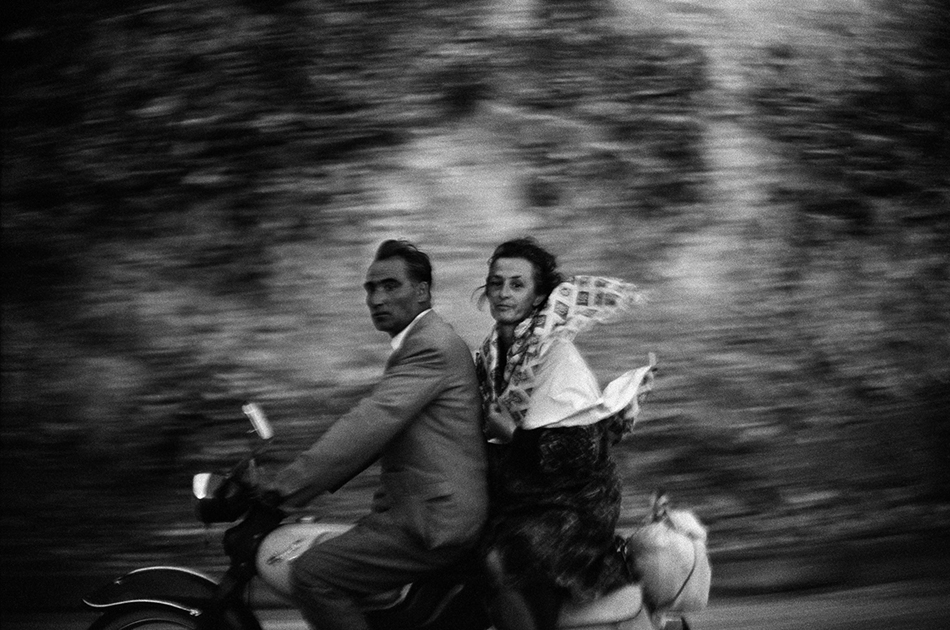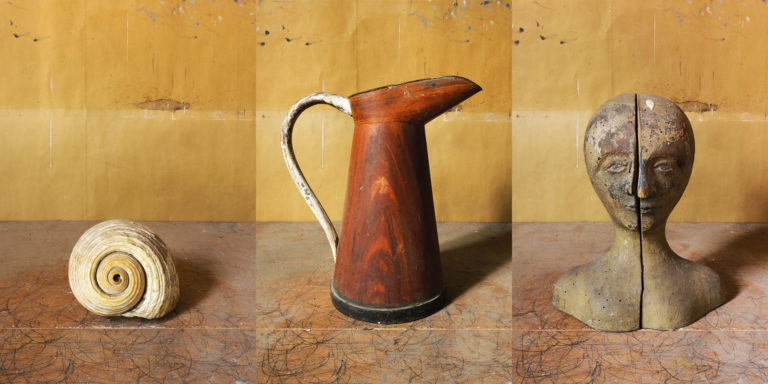
May 14, 2014The photographs of Joel Meyerowitz are the subject of two exhibitions up New York’s Howard Greenberg Gallery (top) through May 31, 2014. “The Effect of France” comprises still lifes inspired by the paintings of Cézanne, including Nine Objects (above), from 2013. All images © Joel Meyerowitz, courtesy Howard Greenberg Gallery, New York
Joel Meyerowitz’s twin shows on view at New York’s Howard Greenberg Gallery through May 2014 stand as rough bookends to his substantial photographic career — his career so far, that is. The 76-year-old New Yorker still works every day and never leaves the house without his Leica.
Both exhibitions were conceived and executed in Europe and offer a compelling glimpse into Meyerowitz’s creative train of thought.
The first, “European Trip: Photographs from the Car,” consists of 40 images shot, as the title suggests, while Meyerowitz was driving across the Continent, in 1966 and 1967. There are sheep grazing in front of industrial tankers in Spain; a horse pulling a cart loaded with melons in Istanbul; a cyclist caught in the headlights on a dark Irish country road at night; a couple astride a scooter gazing at the camera, the Greek landscape behind them lost in a blur. Meyerowitz, a master of street photography, says that shooting from a car instead of his normal vantage point — on foot — felt like being inside a camera. “The world was coming to me through the car window; all I had to do was say yes,” he recalled recently, speaking from the converted barn in Tuscany where he spends a significant chunk of every year. “One of the wonders of photography is you can work at one one-thousandth of a second.”
Perhaps most striking to students of Meyerowitz, an early and influential practitioner of color, these “European Trip” photographs are in black and white. “When I began photography in 1962, I started shooting in color because I didn’t know any better,” he says. “It seemed the world was in color, why wouldn’t you shoot in color?” But since color was still difficult to develop in his own darkroom, he took up black and white before definitively switching back to color at the end of the decade.
“The world was coming to me through the car window; all I had to do was say yes.”
Forty-five years later, in 2011, Meyerowitz journeyed to Provence, where he visited Cézanne’s studio. A former painter himself, he was struck by the dark gray walls and Cézanne’s collection of unusual objects, which the artist frequently inserted into still lifes. The following year, the Tuscan summer was stifling. “The heat coming off the baking ground was over one-hundred degrees,” Meyerowitz says. Unable to venture outside to shoot, he looked for something to do inside. He had bought a few random objects at a vide grenier, or attic sale, in France to give to a friend, and he began experimenting with the finds, asking whether “these creatures were animated in some interesting way.” Though not by nature an accumulator, he has since assembled 70 to 80 items — some found, some picked up at markets, some gifts from an Italian friend, but all a little peculiar — and has made roughly 500 pictures with them.

The photographer shoots cast-off objects, some of which belonged to Cézanne’s himself, in the style of traditional portraits.
A tiny fraction of the results are seen in “The Effect of France,” the second show at Howard Greenberg. Meyerowitz captured the objects — a green ceramic teapot or a leaf here, a glass vessel or an oddly shaped piece of metal of unknown function there — alone or in carefully arranged groups against backdrops he constructed and painted with a gentle nod to Cézanne. He even returned to Cézanne’s studio and made a group portrait of the late artist’s old bottles. The effect throughout is akin to portraiture, highlighting the individuality, sensuality and ambiguity of each item. The colors are muted and mottled, giving the photographs a palpable texture. He also sees a certain theatricality to the project: “They’re all cast-offs,” he says. “The opportunity with a still life is to bring them back on the stage and have them perform.”
What connects the two shows, in Meyerowitz’s mind, is the central thrust of his oeuvre: “asking questions of the medium.” While there is an inescapable beauty to both the old and new images, that’s secondary. What Meyerowitz seems to be playing with is the unknowable, whether the mystery lies in the life stories of the people in a passing car or the history of a man’s faded black bowler, dusty and worn.








